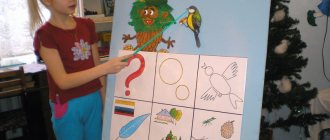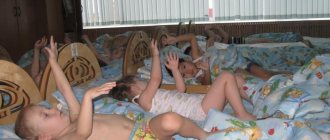Technology of problem-based learning in preschool educational institutions
The problem-based teaching method is an organized sequence of interaction with preschoolers, which presupposes the presence of problematic situations and the ability to independently resolve them at any age. At the final stage, you can include an analysis of the completed methodology. Lessons in older groups develop children's critical thinking.
Active search for a solution to the problem
Important ! In pedagogy, the teaching of the educational process is based on ICT technologies, gaming, the implementation of the project method and the use of integrations. They help teach preschoolers using examples of difficult situations, introduce and effectively use new knowledge.
In the context of the implementation of federal state educational standards, technology contributes to the development of creative abilities.
Story
The history of the project for this type of training begins in the 20s of the last century. The definition was given by John Dewey. The author believed that the child should be expected to master the material not only with the help of speech and senses, but also to give him the opportunity to satisfy the need for knowledge himself with the help of various sources, discussions, necessary literature and brief technological maps.
Advantages and disadvantages
Pros:
- The student gains high independence,
- Motivation and cognitive interest are formed,
- Thinking abilities develop.
Minus:
- To acquire a certain amount of knowledge, you need to spend a lot of time.
Technology of problem-based learning in preschool educational institutions, methodological development on the topic
“Technology of problem-based learning in kindergarten.”
In life, our children often encounter certain difficulties, but we – adults – protect children from them, not giving them the opportunity to think for themselves, experiment, and, finally, cope with problems on their own.
Why is this happening? Most often due to the lack of our time, due to the possibility of danger in some situations for the child. We consider our children to be insufficiently competent in many issues, unable to understand problems and find a way out of them. Children get used to asking adults for help and hints, and grow up unprepared for the realities of life. But a problematic situation does not always become a problem for the child. We can talk about this phenomenon only if children have shown interest in this problem. It depends on the skill of the teacher whether children will be interested in new material presented in the form of a problem or not.
The main task of the kindergarten is to fill the daily life of the child in the group with interesting activities, ideas, problems, and to include each child in meaningful activities. The teacher’s goal is to arouse the child’s interest in problematic situations and the desire to creatively solve them.
The emergence of such an innovative trend in preschool pedagogy as problem-based learning is associated with the ideas of the American educator and psychologist John Dewey, who founded an experimental school in Chicago in 1894. The author developed an entire education system, which was later called “learning by doing.” The basis of education was not the curriculum, but games and work activities.
In Russia, domestic psychologists I. Ya. Lerner, T. V. Kudryavtsev, A. M. Matyushkin, M. I. Makhmutov, M. N. Skatkin were engaged in problem-based learning; they argue that the essence of problem-based learning is in posing a problem to the child, cognitive task, creating conditions for exploring ways and means of solving it so that the child himself obtains knowledge.
Problem-based learning in kindergarten is an organization of interaction with students that involves the creation, under the guidance of a teacher, of problematic issues, tasks, situations and the active independent activity of children to resolve them.
With problem-based learning, the teacher’s activity changes radically: he does not present children with knowledge and truth in a ready-made form, but teaches them to see and solve new problems and discover new knowledge. What is problem-based learning?
The essence of problem-based learning in kindergarten is that the teacher creates a cognitive task, situation and provides children with the opportunity to find means of solving it, using previously acquired knowledge and skills. Problem-based learning activates children's thoughts, makes them critical, and teaches them independence in the process of learning.
Each new knowledge reveals to the child little-known aspects of the cognizable object, arouses questions and guesses.
How to organize the cognitive activity of children in order to develop mental processes? (sensations, perception, memory, imagination, thinking, as well as speech development).
In each specific case, the teacher himself decides in what form to work with children: in a group or individually. However, in order to develop children’s ability to doubt and think critically, preference should be given to group forms of work. It is easier for a child to be critical of peers than of adults. A doubt, a guess, an assumption arises when he compares his point of view with the opinion of another person. Communication and joint activities with adults develop the child’s ability to set goals and act, imitating him. And in joint activities with peers, the child begins to use forms of adult behavior, control, evaluate, disagree, and argue. This is how the need arises to coordinate your actions with the actions of your partners and accept their point of view. Therefore, cognitive activity is organized in the form of a dialogue between the child and the teacher and other children in the group. The indicators of such a dialogue are ease of communication and democratic relations.
The formulation of a problem problem and the process of solving it occurs in the joint activity of the teacher and children. The teacher engages the students in a joint mental search and provides them with assistance in the form of instructions, explanations, and questions. Cognitive activity is accompanied by heuristic conversation. The teacher poses questions that encourage children, based on observations and previously acquired knowledge, to compare, juxtapose individual facts, and then come to conclusions through reasoning. Children freely express their thoughts, doubts, follow the answers of their comrades, agree or argue.
Basic psychological conditions for the successful application of problem-based learning
1. Problem situations must meet the goals of developing a knowledge system.
2. Be accessible to students.
3. Must generate their own cognitive activity and activity.
4. The tasks should be such that the student cannot complete them based on existing knowledge, but sufficient for independent analysis of the problem and finding the unknown.
Why is modern education actively introducing this technology?
Advantages of problem-based learning:
1. High independence of students;
2. Formation of cognitive interest or personal motivation of students;
3. Development of children's thinking abilities.
Flaws
Requires a lot of time to master the same amount of knowledge.
Problem-based learning includes several stages:
1) awareness of the general problem situation;
2) analysis of the problem situation, formulation of a specific problem;
3) solving the problem (proposing, substantiating hypotheses, sequentially testing them);
4) checking the correctness of the problem solution.
Forms of organizing problem-based learning in preschool educational institutions.
Are there the following forms of organizing problem-based learning?
- Problematic question
- Problem task
- Problem situation
- Problematic question: this is not simply a reproduction of knowledge that is already familiar to children, but a search for an answer based on reasoning.
“Why do you think in nature you can find both green and yellowish-brown lizards?”
“Why do some puddles on the site dry up quickly, while others do not dry out for a long time?”
That is, the question “When do the leaves fall?” assumes a specific answer based on knowledge - it's just a question.
To the question “Why do the leaves fall in the fall?” is problematic because requires children to use reasoning when answering it.
Problem questions contain in the test the questions “why?”, “why”?
For example, which birds of our region are the last to fly south? (just a question)
Why are wild ducks and geese the last to fly south? (problematic question).
Why does a duck swim but a chicken doesn't?
Why aren't shoes made of iron?
2) Problem task: The problem task can be divided into two parts. Does it contain a condition (description) and a question?
Examples of problematic tasks.
Problematic task No. 1.
Pinocchio dropped the key into the water, he needs to get it out, but after jumping into the water, Pinocchio floats up. How can I help him?
Children reason: “Pinocchio is made of wood, and wooden objects do not sink in water,” “Wood is lighter than water, so Pinocchio cannot dive for the key.” In the course of reasoning, they demonstrate their knowledge about the properties of wood, and then, due to their creative abilities, come to find an answer to this problematic problem. “You can look for a key at the bottom with a magnet on a string, if the key is metal,” “You can dive to the bottom with scuba gear, as divers do,” “You can pick up a load, for example, a stone, and then leave it at the bottom and float up.”
Problematic task No. 2..
— One friend lives in the south and has never seen snow. The other lives in the Far North. The snow never melts there.
What can be done so that a friend living in the north sees trees and flowers, and a friend living in the south sees snow and ice. However, they do not want to move.
Problematic task No. 3
— The children made two identical snowmen. One melted within a week, and the other stood until the end of winter.
Why?
3) Problem situation.
A problem situation is the most complex form of problem-based learning.
When solving a problem situation, a state of mental difficulty arises in children, caused by the insufficiency of the knowledge and methods of activity previously acquired by them. It is the problematic situation, according to psychologists, that constitutes the necessary pattern of creative thinking. Contradiction is the main link of a problem situation.
(Contradiction is a situation in which one thing excludes another, incompatible with it, opposite to it.)
Problem situation No. 1, metal objects sink in water, but a ship built of metal floats. There is a contradiction, uncertainty, why?
In order to solve this problem situation, the teacher organizes a series of experiments with objects, demonstrating that a metal weight placed in water immediately sinks, but the same weight placed on a metal lid does not sink. Why? What keeps it afloat? The teacher prompts the children to find the answer with questions, noting that the lid is filled with air, because there are sides. The higher the sides, the more air there is in the lid, and, consequently, a larger load can be held on it without drowning.
Examining the ship, the children come to the conclusion that its underwater part is hollow and filled with air, so the ship, made of metal, does not sink.
Problem situation No. 2, the teacher invites children to roll balls made of different materials (wooden, plastic, rubber, glass, metal) along an inclined board. Children perform actions and see that all the balls roll down and the metal ones stop in the middle of the board.
The unknown in this case is why only the metal ball stopped in the middle of the board.
A contradiction arose: the ball should roll, but it didn’t.
Children think and try to express their assumptions. Those who are not familiar with the properties of a magnet are in difficulty.
Next comes the moment of cognitive activity. Children examine the board to find the reason why the metal balls stop. They show their creative abilities - they suggest something. If someone already has knowledge about the properties of a magnet, they can correctly resolve the contradiction that has arisen without examining the board. Examination of the board and the discovery of a magnet attached to its reverse side completely resolves the contradiction that arose in all children. This introduction to the properties of a magnet will be remembered better than all the stories told by adults, because it is based on emotional perception.
This problematic situation was specially created by the teacher, but very often problematic situations arise naturally. In this case, the teacher is obliged to help children see the contradiction, the inconsistency noticed by one child (or several), and include them in active search activities.
- Techniques for creating problem situations when working with preschoolers
- Focusing children's attention on the contradiction between knowledge and life experience.
- Encouraging children to compare, generalize, draw conclusions, and compare facts by asking heuristic and problematic questions.
- Consideration of a problem from different positions, often role ones.
- Creating a contradiction, a problematic situation.
- Organization of contradictions in the practical activities of children
Requirements for problem situations:
— the solution to a problem situation should be focused on maximum independence and creative activity of the child;
- the problem must correspond to the educational information that is being learned
the child, as well as the information he already has;
- the formulation of the problem should be as clear as possible and free from
words and expressions that are incomprehensible to children;
- a problematic situation should create sufficient difficulty in solving it and at the same time be feasible for the child. This will create a need to solve it;
- the problem situation should challenge children's curiosity;
- in the process of solving a problem, there should be a need to consider new situations related to it;
- the problem situation should be constructed taking into account the basic didactic
principles of learning;
— there must be a contradiction at the heart of the problem situation.
Recommendations for communication style with children
Listen to everyone who wants to. Give only positive ratings. Instead of “correct”, it is better to say “interesting”, “unusual”, “curious”, “good”. During conversations, follow the child’s logic, and do not impose your opinion. Teach your children to object to you and each other, but to object with reason, offering something in return or proving it. If there is a bright leader in the group, over time switch him to some activity and talk with the children without him. In developing children's creative abilities, use active forms of learning - group discussions, brainstorming, role-playing games, group and individual projects, solving situational problems.
EXAMPLES OF SITUATIONAL TASKS FOR THE DEVELOPMENT OF THINKING IN CHILDREN.
• There is a fire in the apartment. What will you do? Why?
• Smoke in the neighboring apartment. Your actions?
• You see someone drowning. What will you do?
• A faucet in the apartment burst. Are you alone at home now. What will you do first, what will you do next? Why?
• Fairy tale “Turnip”. Grandfather has a bad harvest: the turnip has not grown. How can I help him?
•Mashenka got lost in the forest and doesn’t know how to announce herself and get out of the forest.
• Dunno injured his leg in the forest, but there is no first aid kit. What can be done.
As a result of work to introduce problem-based learning in preschool educational institutions, children become more active, observant and sociable. They themselves “see” problem situations, formulate contradictions, and find different solutions. Children develop cognitive interest, a desire to explore, experiment, reason and prove
Classification of problem-based learning methods
Problem-based learning methods are:
- Heuristic. The problem is formulated by the teacher, and then the students are involved in discussing the solution.
- Reproductive – building classes according to a model. An example of a difficult situation is given with instructions on how to find contradictions.
- Problem presentation. Passive method, where students observe the entire process, which is formulated by the teacher.
- Research. The most difficult: the teacher formulates the problem, and the students do the rest of the work.
Classification of methods according to M.I. Makhmutov.
Classifications of problem situations, ways to create them
Teaching experience represents 20 difficult situations qualifications. Their three general classes are:
- First. The unknown is a goal to be learned,
- Second. The unknown is a mode of action.
- Third. New conditions of action are considered unknown.
Organizational moment in kindergarten before class
Note ! One of the pedagogical technologies of problem-based learning is the case method. It's universal. With its help, a specific situation is described, during which the essence of the problem is understood, possible solutions and the choice of the best one. The material is as close to the real thing as possible; all students, including the teacher, interact.
A way to create such situations is to encourage students to make comparisons. The student must compare facts, phenomena, data that contradict the given goal. For example, in biology classes, with the help of a presentation, a preschooler must find an error or contradictory data.
When to use the method
Complexity is considered to be a correctly created problem situation. Therefore, this method requires skills and abilities.
Solving difficult situations in the preparatory group of preschool educational institutions
Rules:
- The problem described is age appropriate,
- It is not solved by previous knowledge, but by learning to find new ones,
- The situation contains contradictions,
- The situation arouses interest and motivation.
Stages of problem-based learning technology
- Statement of a problem in the process of which a difficulty arises for the student.
- The search for a solution begins using dialogues or hypotheses.
- Hypotheses are being tested. It's worth starting with a false one.
- Rules and methods for solving the tasks are formulated. Comparison with a sample.
- Training in posing problematic questions.
- Control and verification work is carried out.
“Technology of problem-based learning in kindergarten.”
-Techniques for creating problem situations when working with preschoolers
- Focusing children's attention on the contradiction between knowledge and life experience.
-Encouraging children to compare, generalize, draw conclusions, and compare facts by asking heuristic and problematic questions.
-Consideration of any problem from different positions, often role ones.
-Creating a contradiction, a problematic situation.
-Organization of contradictions in the practical activities of children
Requirements for problem situations:
— the solution to a problem situation should be focused on maximum independence and creative activity of the child;
- the problem must correspond to the educational information that is being learned
the child, as well as the information he already has;
- the formulation of the problem should be as clear as possible and free from
words and expressions that are incomprehensible to children;
- a problematic situation should create sufficient difficulty in solving it and at the same time be feasible for the child. This will create a need to solve it;
- the problem situation should challenge children's curiosity;
- in the process of solving a problem, there should be a need to consider new situations related to it;
- the problem situation should be constructed taking into account the basic didactic
principles of learning;
— there must be a contradiction at the heart of the problem situation.
Recommendations for communication style with children.
Listen to everyone who wants to. Give only positive ratings. Instead of “correct”, it is better to say “interesting”, “unusual”, “curious”, “good”. During conversations, follow the child’s logic, and do not impose your opinion. Teach your children to object to you and each other, but to object with reason, offering something in return or proving it. If there is a bright leader in the group, over time switch him to some activity and talk with the children without him. In developing children's creative abilities, use active forms of learning - group discussions, brainstorming, role-playing games, group and individual projects, solving situational problems.
EXAMPLES OF SITUATIONAL TASKS FOR THE DEVELOPMENT OF THINKING IN CHILDREN.
• There is a fire in the apartment. What will you do? Why?
• Smoke in the neighboring apartment. Your actions?
• You see someone drowning. What will you do?
• A faucet in the apartment burst. Are you alone at home now. What will you do first, what will you do next? Why?
• Fairy tale “Turnip”. Grandfather has a bad harvest: the turnip has not grown. How can I help him?
•Mashenka got lost in the forest and doesn’t know how to announce herself and get out of the forest.
• Dunno injured his leg in the forest, but there is no first aid kit. What can be done.
As a result of work to introduce problem-based learning in preschool educational institutions, children become more active, observant and sociable. They themselves “see” problem situations, formulate contradictions, and find different solutions. Children develop cognitive interest, a desire to explore, experiment, reason and prove
Typical lesson structure
The structure of a problem lesson includes:
- Repetition of previous knowledge,
- Learning new ways of doing things,
- Formation of skills and abilities
Development of the cognitive process in a preschool educational institution at the time of solving a difficult situation
Additional Information . When developing a new rule, the “aha reaction” is used. In this case, all students jointly choose the most correct option.
Basic psychological conditions for the use of problem-based learning
Important conditions are:
- Availability and understanding of the rules by all students,
- The process should arouse interest, cognitive activity,
- Tasks should be selected so that the student cannot use previous knowledge when solving them.
Drawing lessons in older groups of kindergarten on the theme “Spring”
Methodological techniques for creating problem situations
8 methodological techniques:
- “Lead” the student into contradiction,
- To confront the contradiction with practice,
- Express different points of view on one question,
- Looking at the problem from different angles,
- Encouraging the student to draw conclusions and comparisons,
- Ask specific questions
- Offer tasks for practice,
- Demonstrate facts unknown to the student.





